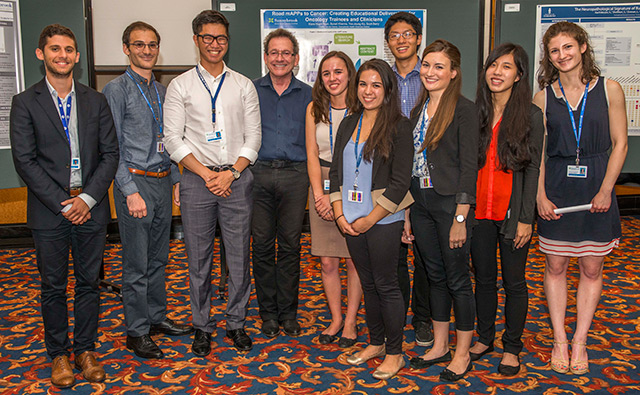Poster competition turns on the heat
By Eleni Kanavas
As the Canadian National Exhibition marks the summer drawing to an end, so does the annual Best Summer Research Project competition hosted by Sunnybrook Research Institute (SRI).
With 74 entrants, it was the largest, most competitive contest ever. It concluded this year’s D+H SRI Summer Student Research Program. Undergraduate students from Canadian universities had a chance to share the results of their diverse research projects and compete for a cash prize. The entries included 17 from Biological Sciences, 35 from Evaluative Clinical Sciences and 22 from Physical Sciences.
Students showcased their posters to judges and others checking out the event held Aug. 20, 2015 at Sunnybrook. It also gave students an opportunity to see the work of their peers.
“I think it’s a wonderful opportunity for summer students to be able to present their work in this kind of forum to colleagues and scientists of many different fields,” said Dr. Cari Whyne, director of the Holland Musculoskeletal Research Program, who was one of the judges. “Everyone really stepped up to show how the work that they’ve done integrates into the broader laboratory setting that they are in, and how the focus of the research fits into the clinically relevant scenario of the work that we do at Sunnybrook.”
Judges comprised of SRI faculty, postdoctoral fellows and graduate students from each platform evaluated students based on the quality of their posters, communication skills and scientific merit of their projects.
Each student gave a “guided-tour” of their posters that illustrated and explained the methods, observations and results of the experiments they developed with their supervisors and mentors. They also answered questions about their work.
The four-month program, made possible by a donation from D+H Corporation, aims to give students hands-on training in the fundamentals of scientific investigation while being mentored by SRI scientists. The placements give students a unique hospital-based research experience that promotes the postgraduate field as a career. Within the studentship program, SRI also hosts a weekly seminar series that highlights the research of scientists from across the platforms and programs.
The judges selected the top student from each platform. There were also second- and third-place winners in each platform owing to the number of participants.
Dr. Michael Julius, vice-president of research at SRI and Sunnybrook, congratulated the students on their hard work and announced the winners at the end of the event.
“You are the future generation of scientists. It’s been an absolute privilege to have you with us this summer. I hope each of you enjoyed your sojourn here,” he said. “Most importantly, I hope it got you out of bed early every morning because either you wanted to finish the poster, or you wanted to find out the answer to the question you were asking.”
Erica Sacoransky, who was supervised by Dr. Avery Nathens, placed first in Evaluative Clinical Sciences. Her project aimed to determine the rate of local undertriage (underestimating the severity of an illness or injury) and characterize undertriaged patients.
“I compared the injury characteristics of patients who were brought directly from the field to the burn centre with patients who were transferred to the burn centre from an emergency department,” she said. “Analyzing these trends will help to improve the current burn triage guidelines to optimize triaging accuracy, [which] is crucial in order to reduce delays in definitive care and optimal resuscitation.”
Entering her third year of studies in kinesiology at the University of Toronto, Sacoransky said this was the first time she had worked in a hospital-based research institute. “I feel very fortunate to be involved with SRI and work with a strong team from whom I learned a lot. Overall, it was a very positive experience and I would highly recommend it to other students.”
Other award winners included the following.
First place
- Robert Yao (Biological Sciences, supervised by Dr. Saeid Amini-Nik and Dr. Marc Jeschke): “Macrophages steer CD90 positive mesenchymal cells to the wound bed during skin healing: a mechanism of impaired healing in elderly.”
- Solomon Grant (Physical Sciences, supervised by Dr. Stuart Foster): “Optimizing omnidirectional light delivery for an intravascular photoacoustic array probe.”
Second place:
- Vivian Tia (Biological Sciences, supervised by Dr. Juan Carlos Zúñiga-Pflücker): “Generation of T-lineage cells from stem cells using a multimeric Delta-like 4 notch activator.”
- Sharef Danho (Evaluative Clinical Sciences, supervised by Dr. Junaid Bhatti): “Risk-taking behaviours and non-engagement in weight management: are they associated?”
- Stefania Assimopoulos (Physical Sciences, supervised by Dr. Nilesh Ghugre): “Contribution of hemorrhage in myocardial infarction using T1 MRI relaxation parameter.”
Third place:
- Anna Cotic (Biological Sciences, supervised by Dr. Marc Jeschke): “Evaluating the role of adipose tissue on hepatic metabolic function post-burn using an ex vivo approach.”
- Justin Kim (Evaluative Clinical Sciences, supervised by Dr. Laurent Milot): “Use of gadolinium-enhanced MRI as a marker of pathologic response to chemotherapy & predictor of patient outcomes in a nonsurgical population with colorectal liver metastases.”
- Olivia Hough (Physical Sciences, supervised by Dr. Kullervo Hynynen): “Blood-brain barrier closure time following controlled ultrasound disruption is independent of opening volume.”
First-place winners received $500; second-place winners, $300; and third-place winners, $200. All winners will receive individualized awards and the top students will also have their names engraved on display plaques at SRI.
Read more about the D+H SRI Summer Student Research Program, including stories profiling some of this year’s students, by visiting the education and training section of the SRI website.





